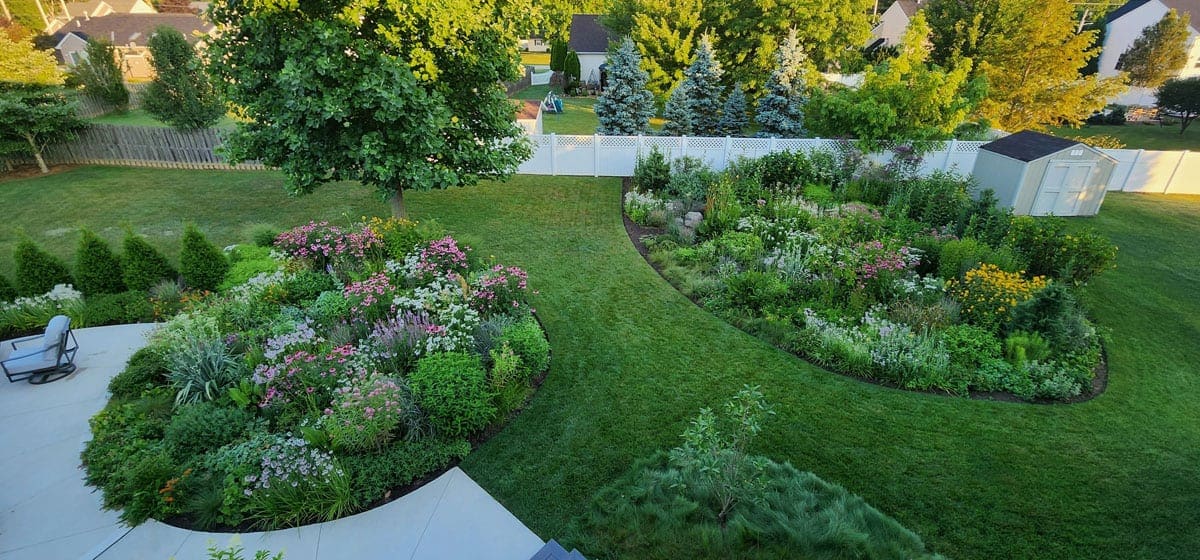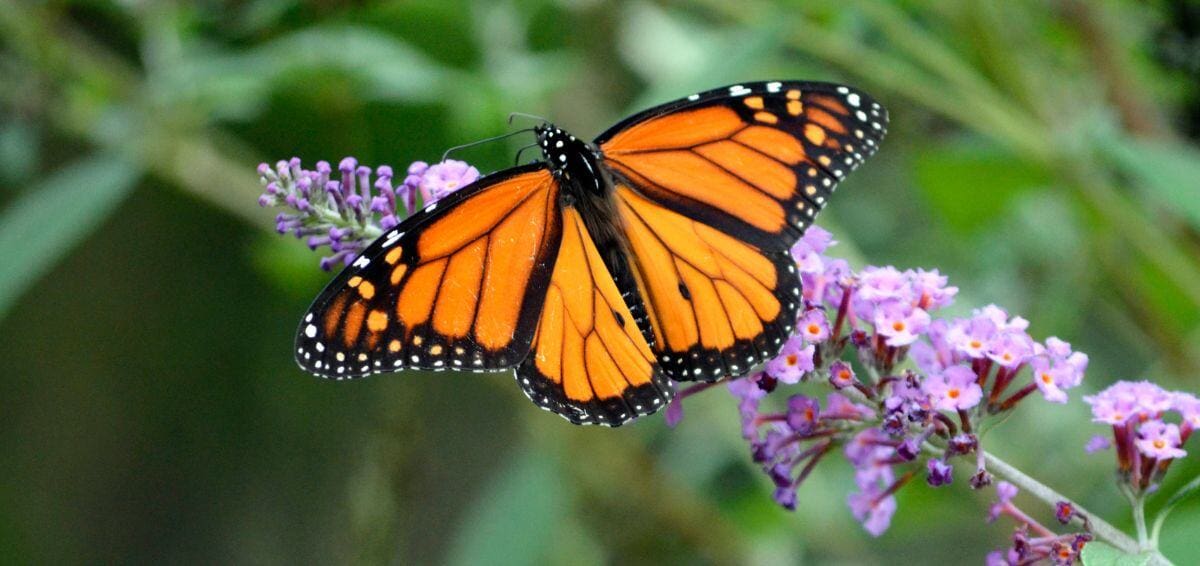Pollinator gardens are becoming increasingly popular among homeowners in Northeast Ohio. These gardens are designed to attract and support pollinators such as bees, butterflies, and hummingbirds by providing a diverse selection of nectar-rich flowers, shrubs, and native plants. Anyone, regardless of the size of their space, can contribute to pollinator conservation by establishing their own pollinator garden.

With pollinators facing population declines due to habitat loss and environmental changes, homeowners have an opportunity to make a difference while also enhancing their outdoor spaces. Pollinator gardens not only benefit the environment but also create a beautiful, low-maintenance landscape that can improve property value and reduce the need for chemical fertilizers.
Lifestyle Landscaping specializes in designing and installing pollinator gardens that thrive in Northeast Ohio’s climate. Whether you have a small backyard or a large property, a well-planned pollinator garden can provide lasting beauty while supporting local ecosystems.
Key Takeaways
- Pollinator gardens help support declining bee and butterfly populations.
- Native plants in these gardens require less maintenance and water.
- A well-designed pollinator garden enhances curb appeal and biodiversity.
- Pollinators play a crucial role in sustaining food production and healthy ecosystems.
- Northeast Ohio homeowners can incorporate a variety of native plants to attract beneficial insects.
What is a Pollinator Garden?
A pollinator garden is a thoughtfully designed outdoor space filled with plants that attract and support essential pollinators. These gardens include flowers, shrubs, and trees that provide nectar and pollen, as well as host plants that serve as breeding grounds for butterflies and other beneficial insects.
Native bees thrive in environments rich in native plant species, which provide essential resources like nectar and pollen, thereby creating a supportive ecosystem for these vital pollinators.

Unlike traditional gardens, pollinator gardens emphasize biodiversity and sustainability by using native plants that thrive in local climates. The goal is to create an environment that sustains pollinators throughout their life cycles while requiring minimal maintenance from homeowners.
The Decline of Native Pollinators and Why It Matters
Pollinators, including bees, butterflies, moths, and hummingbirds, are facing a significant decline due to habitat loss, climate change, and pesticide use.

- More than 40 percent of pollinator species, particularly bees and butterflies, are at risk of extinction.
- Native bee populations in North America have declined by nearly 50 percent in the past century.
- Monarch butterfly populations have dropped by more than 80 percent due to the loss of milkweed, their primary host plant.
Bumblebees play a crucial role in pollination, particularly for plants like yarrow and sunflowers, which provide accessible food sources for them. These plants help support biodiversity and healthy ecosystems.
Pollinators are essential for food production and ecosystem health. Nearly 75 percent of flowering plants depend on pollinators for reproduction, and one out of every three bites of food consumed globally is made possible by pollination. By planting a pollinator garden, homeowners can play a role in restoring lost habitats and providing much-needed resources for these vital species.
Environmental and Ecological Benefits of a Pollinator Garden
Pollinator gardens provide a range of environmental benefits, making them an excellent choice for homeowners looking to adopt more sustainable landscaping practices. Plant diversity is crucial in enhancing garden ecosystems and supporting pollinators like bees and butterflies, as a varied selection of plants fosters a rich habitat for beneficial insects and improves fruit production. The benefits of a pollinator garden include the following:
- Improve air quality by supporting native plants that require fewer fertilizers and pesticides.
- Reduce soil erosion by incorporating deep-rooted perennials that stabilize the ground.
- Encourage biodiversity by attracting beneficial insects and birds.
- Minimize water usage, as native plants typically require less irrigation than traditional lawns.
- Help combat climate change by promoting plant species that capture and store carbon dioxide.
How a Pollinator Garden Enhances Your Home
Beyond their environmental benefits, pollinator gardens can significantly enhance a home’s landscape and overall appeal. These gardens can do the following:
- Increase curb appeal with a vibrant and colorful display of flowers.
- Boost property value as eco-friendly landscaping becomes a desirable feature for homebuyers.
- Reduce lawn maintenance by replacing high-maintenance grass with resilient perennials and wildflowers.
- Create a peaceful, nature-filled retreat for relaxation and enjoyment.
Incorporating flowering trees into your pollinator garden is crucial as they provide consistent nectar and pollen throughout the growing season, supporting bees, butterflies, and other pollinators.
A well-planned pollinator garden can also attract beneficial insects that naturally control pests, reducing the need for chemical treatments in the yard.
Best Native Plants for Pollinators in Northeast Ohio
Choosing the right plants is essential for creating a thriving pollinator garden. Native plants are preferable because they are well-adapted to the local climate, require less maintenance, and provide the specific nectar and pollen sources that regional pollinators depend on. Native wildflowers, such as Rudbeckia (commonly known as Black-Eyed Susan), are particularly beneficial as they attract pollinators and predatory insects with their nectar-filled centers.

The best approach is to use a variety of native plants that bloom at different times throughout the growing season. Ohio native plants play a crucial role in supporting pollinator populations, making them an essential addition to any garden. Native plants require less water and fertilizer than non-native species, making them an excellent choice for low-maintenance gardening.
Design Tips for a Thriving Pollinator Garden
A well-planned garden layout ensures that pollinators can easily locate food sources and shelter. Here are some key design strategies:
- Select a sunny location, as most pollinator plants thrive in full sun.
- Group plants in clusters to make them more visible and accessible to pollinators.
- Incorporate a mix of flower colors, as different species are attracted to specific hues.
- Plant flowers with varied bloom times to provide a continuous food source from spring through fall.
- Avoid pesticides and herbicides as they can harm pollinators.
- Include a shallow water feature, such as a birdbath or small pond with pebbles for bees and butterflies to hydrate.
Common Mistakes to Avoid
Pollinator gardens require thoughtful planning to maximize their benefits. Even small pollinator gardens can make a meaningful difference by providing essential resources for pollinators in urban and suburban spaces. Some common mistakes to avoid include:
- Planting only one type of flower, which limits biodiversity and seasonal food sources.
- Using non-native plants or invasive species that may disrupt local ecosystems.
- Not considering bloom timing, leading to food shortages for pollinators during certain seasons.
- Overusing mulch, which can prevent ground-nesting bees from accessing soil.
- Failing to provide a variety of flower shapes and sizes to accommodate different pollinators.
FAQs About Pollinator Gardens
What are the best plants for a pollinator garden in Ohio? The best plants for a Northeast Ohio pollinator garden include native perennials like milkweed, bee balm, purple coneflowers, black-eyed Susans, and goldenrod.
How much maintenance does a pollinator garden need? Pollinator gardens require less maintenance than traditional lawns. Native plants are adapted to the local climate and typically need minimal watering and care.
Do pollinator gardens attract unwanted pests? Pollinator gardens attract beneficial insects such as bees, butterflies, and hummingbirds. These species do not pose a threat to humans, and their presence can actually help control harmful garden pests.
Can I create a small pollinator garden in a limited space? Yes, even a small flower bed, patio planter, or raised garden can serve as a valuable habitat for pollinators. The key is to select nectar-rich flowers and provide a variety of bloom times.
How Lifestyle Landscaping Can Help
For homeowners in Northeast Ohio, installing a pollinator garden can be an excellent way to create a vibrant outdoor space while contributing to local conservation efforts.
Lifestyle Landscaping specializes in designing and installing custom pollinator gardens tailored to Northeast Ohio’s climate and ecosystem. With expert knowledge of native plant species and sustainable landscape design, homeowners can have thriving gardens that attract pollinators and enhance the beauty of their properties.
If you’re ready to transform your outdoor space with a pollinator-friendly garden, contact Lifestyle Landscaping today for a consultation.
